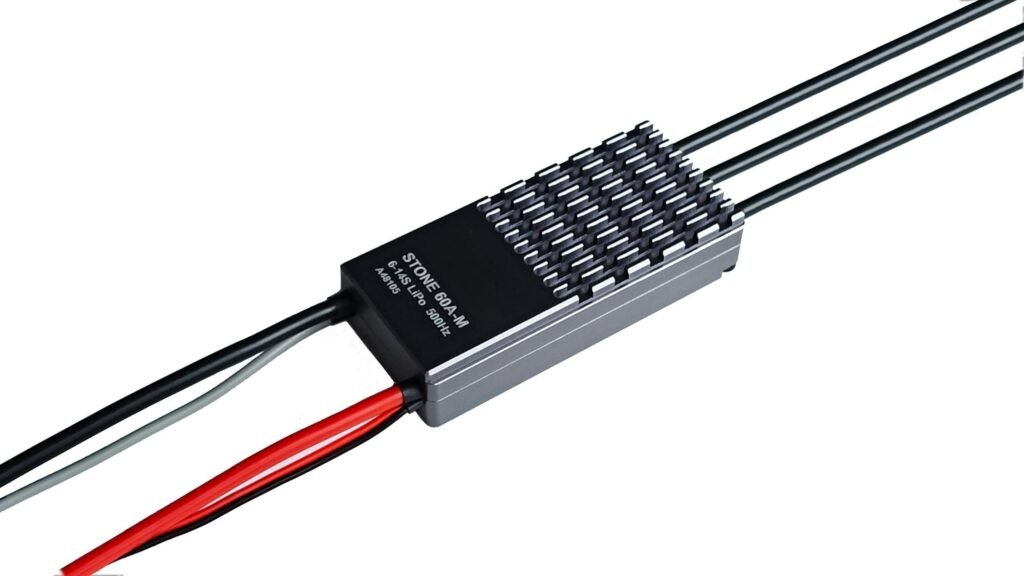
A drone’s ability to achieve stable flight and agile control hinges on one vital element—its power system. At the heart of every capable drone lies a tightly integrated set of components working in unison to deliver propulsion, precision, and performance. This system, composed of four core elements—motor, ESC (Electronic Speed Controller), battery, and propeller—is the driving force that keeps drones soaring through the skies.
In this blog, we’ll dive deep into the working principles, component functions, and practical considerations of a drone power system to help both enthusiasts and professionals better understand how to build, optimize, and maintain efficient aerial platforms.
1. Core Components Explained
(1) Motor: The Heart of the Power System
The motor converts electrical energy into rotational mechanical energy to spin the propellers. There are two primary types used in drones:
| Motor Type | Working Principle | Application Scenarios | Typical Specs |
|---|---|---|---|
| Brushless (BLDC) | Stator windings create a rotating magnetic field that drives a permanent magnet rotor | Multirotor / Fixed-wing drones | 2000–10000 RPM, 85–90% efficiency |
| Brushed | Brushes switch current through the rotor windings to generate motion | Toy drones / Micro UAVs | Higher RPM, ~50 hrs lifespan, 70–80% efficiency |
Key Parameters:
- KV Rating: RPM per volt (e.g., 1000KV × 12V = 12000RPM)
- Power: Indicates lifting capability. Power (W) = Voltage (V) × Current (A)
- Size: Commonly denoted like “2212,” which means 22mm stator diameter and 12mm height
(2) ESC: The Brain Behind the Power
An ESC manages how much and how fast electrical power is sent to the motors. Its performance and protection mechanisms are critical for flight safety.
Main Functions:
- Signal Conversion: Translates PWM signals from the flight controller to motor control commands
- Current Regulation: Adjusts motor speed and direction in real time
- Built-in Protections: Includes overcurrent, overheat, stall, undervoltage, and startup protections
Case Highlight – imotorfly ESCs
As a leading ESC manufacturer, imotorfly has dedicated over a decade to UAV power control technology. Its flagship ROCK series ESCs offer:
- Safe Design: Optimized algorithms, redundant systems, and anti-interference hardware ensure stability even under extreme conditions.
- High-Efficiency Control: In-house developed FOC (Field-Oriented Control) algorithms improve current utilization, extending battery life.
- All-Terrain Adaptability: Operating range from -40°C to 85°C, IP55 waterproof rating; ideal for VTOLs, mapping drones, and agriculture UAVs.
(3) Battery: Energy Reservoir
The battery stores and supplies energy for the entire system. Choosing the right type is essential to balance performance and longevity.
| Battery Type | Energy Density (Wh/kg) | Cycle Life | Charging Features | Common Use Cases |
|---|---|---|---|---|
| LiPo (Lithium Polymer) | 200–260 | 300–500 cycles | Supports 2C–6C fast charge | Consumer-grade drones |
| LiFePO4 | 130–180 | 2000+ cycles | Excellent safety profile | Industrial long-endurance UAVs |
Key Metrics:
- S Rating: Number of cells in series (e.g., 3S = 11.1V)
- Discharge Rate (C): Defines how quickly current can be drawn (5C for a 1000mAh battery means 5A continuous discharge)
- Capacity (mAh): Affects flight duration
(4) Propellers: The Force Converter
Propellers transform motor torque into lift and thrust. Their design impacts efficiency, stability, and noise levels.
Structural Categories:
- Materials: Nylon (impact-resistant), Carbon Fiber (lightweight & strong), Wood (low-noise)
- Size: “1045” means 10-inch diameter, 4.5-inch pitch
- Rotation: Must be paired in clockwise (CW) and counter-clockwise (CCW) sets
Aerodynamic Concepts:
- Pitch: The distance a propeller moves forward in one full rotation—higher pitch = more thrust
- Blade Count: 2-blade (higher efficiency) vs. 3 or 4 blades (quieter, smoother thrust)
2. How the System Works
(1) Signal Flow
The flight controller sends PWM signals (typically 1000–2000µs pulse width) to the ESC → ESC interprets and regulates motor commands → Motor adjusts rotation accordingly
(2) Energy Conversion Pathway
Battery chemical energy → ESC electrical regulation → Motor electromagnetic energy → Propeller mechanical output → Lift / Thrust generation
(3) System Coordination
- Takeoff: ESCs deliver full power, spinning motors rapidly to create vertical lift
- Cruise: Flight controller dynamically balances ESC output for stable flight
- Landing: ESCs reduce current, decreasing motor speed and reducing thrust smoothly
3. Installation & Tuning Essentials
Component Matching Guidelines
- Motor–ESC: ESC current rating should exceed motor’s peak current by at least 20%
- Battery–ESC: Voltage range must be compatible (wide-voltage ESCs offer more flexibility)
- Propeller–Motor: Large props suit low KV motors for lifting; small props fit high KV motors for speed
Safety Best Practices
- ESC Calibration: Calibrate throttle range upon first use
- Battery Care: Avoid deep discharge (keep 20% charge reserve); always use recommended chargers
- Propeller Checks: Ensure correct installation of CW/CCW props; inspect for cracks (replace every ~50 flights)
Maintenance Tips
- Motor Cooling: Keep operating temperature under 70°C, remove debris regularly
- ESC Inspection: Check for swollen capacitors or loose wires (use gold-plated connectors for better reliability)
- Battery Storage: Store at 40–60% charge in a cool, dry place
4. Common Troubleshooting
| Issue | Possible Cause | Solution |
|---|---|---|
| Motor won’t spin | Uncalibrated ESC / Loose signal wire | Recalibrate ESC, check wiring |
| Excessive vibration | Propeller imbalance | Use a balancer or replace the propeller |
| Sudden drop in flight time | Battery degradation / Inefficient ESC | Test battery IR, upgrade ESC |
Conclusion
Optimizing a drone’s power system is a fine balance between power, endurance, and control. Selecting high-quality components and adhering to best installation practices ensures safer flights and better performance. Understanding the internal workings and coordination of each subsystem allows both hobbyists and industry professionals to unlock the full potential of their UAVs—especially in demanding applications like mapping, logistics, and precision agriculture.
Whether you’re building from scratch or upgrading a fleet, mastering these fundamentals is your first step to a smarter, more reliable flight.